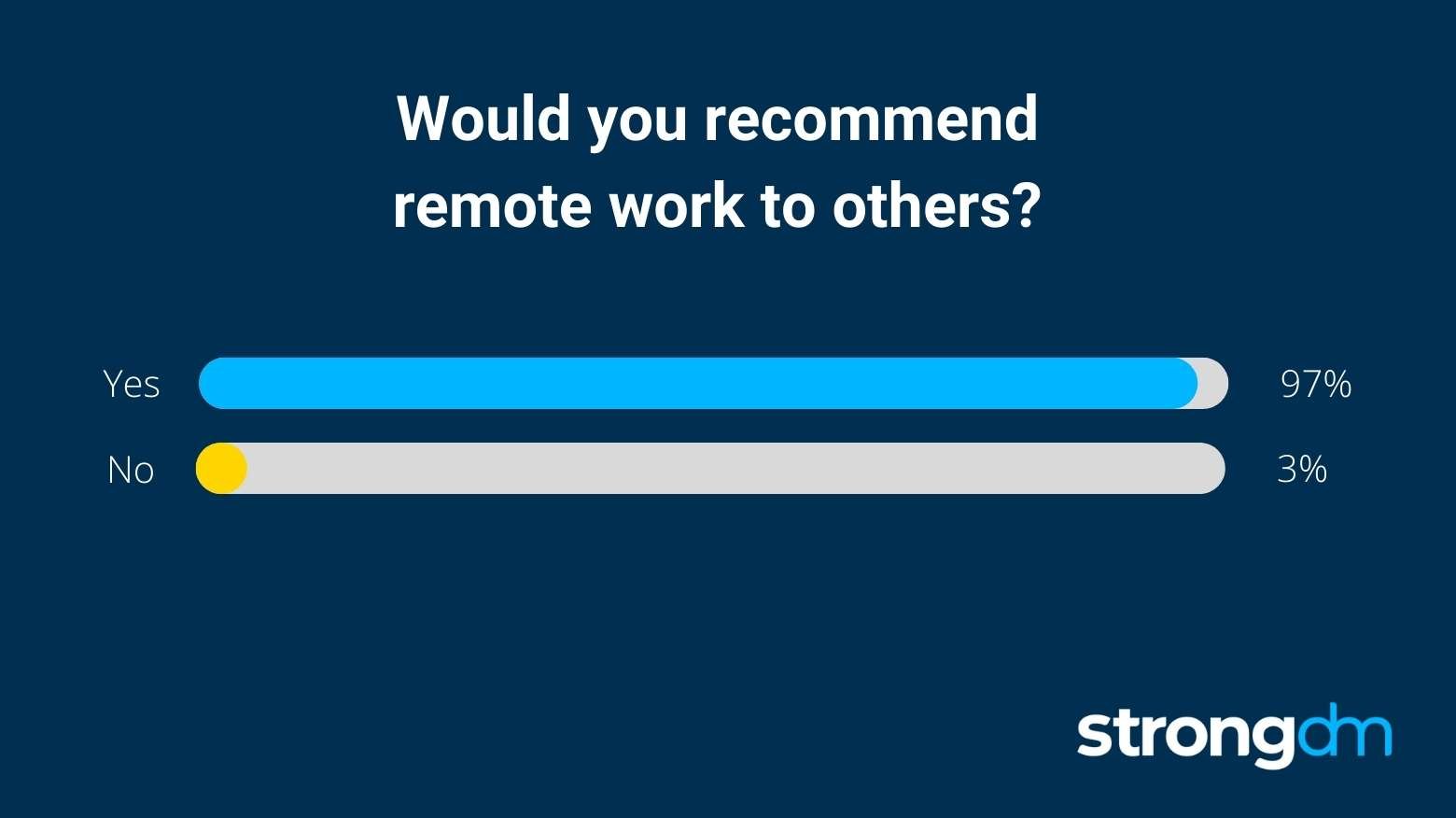

Written by
Raisa YogiamanLast updated on:
October 24, 2025Reading time:
Contents
Built for Security. Loved by Devs.
- Free Trial — No Credit Card Needed
- Full Access to All Features
- Trusted by the Fortune 100, early startups, and everyone in between
The coronavirus pandemic affects many aspects of our lives. Despite the seemingly endless negativity it has created, one positive change happened–the rise of the remote workforce.
In 2020, the world came to a halt. We suddenly realized that many of the jobs we normally do in the office could be done just as efficiently (if not more) from the comfort of our homes.
Two years later, how is remote work faring? Has the enthusiasm for remote work tapered off just like the pandemic? Let’s find out in this list of the latest statistics on remote work.
1. There are now three times more remote jobs compared to 2020
Before the pandemic started, the share of remote-work opportunities in the United States was around 4% of the total available jobs. At the time of writing, remote jobs now make up more than 15% of the total opportunities in the U.S. [1]
Experts state that the growth of remote roles would have happened even without the pandemic. However, the pandemic sped up the inevitable process. If there’s anything we can learn from this statistic, further growth is likely in the future.
2. Remote work makes employees happier
For many of us, the past couple of years has been the first chance to work remotely–and the effects are astounding. According to research by Owl Labs and Global Workplace Analytics, 74% of employees feel happier when they work remotely. The reasons vary from not having to commute to having more flexibility and spending more time with their families. [2]
In fact, the same research states that 50% of surveyed employees would gladly take a pay cut just to have the option of continuing to work remotely. So if you’re asking your employees to return to the office now that the pandemic is on its way out, maybe it’s time to reconsider this mandate.
3. The vast majority of remote employees would recommend remote work to others
One of the best resources on remote-work culture is the Buffer State of Remote Work. They surveyed some remote employees to learn about their experiences in working remotely. Needless to say, the past two years have been quite interesting.
According to Buffer, 97% of people recommend remote work to others. If you take a look at their data from previous years, you’ll see this number fluctuating by only a percent or two. Coincidentally, 97% of remote employees want to continue working remotely until the end of their careers. [3]
This means that employers should start preparing long-term strategies for the onboarding, development, and career growth of remote employees. While “winging it” was a good enough strategy during the pandemic, business leaders should prepare for a (primarily) remote future.
Last but not least, if remote work was your temporary strategy, you might see your employees fleeing if you suddenly start calling them back to the office. If you can’t offer remote work, plenty of companies can offer them this work flexibility.
4. Remote work does not eliminate burnout
One of the most significant issues in the workplace is burnout. With the increased flexibility of remote work, you would think that it would be a non-issue. However, research by Monster says otherwise. 69% of remote employees are experiencing burnout, which is an alarming statistic, but an important one to learn from. [4]
Working remotely does eliminate some sources of stress, such as commuting and a rigid/hectic work schedule. However, there is still the issue of meeting deadlines, being fully productive, and getting promoted–similar issues to working from the office. Furthermore, when working remotely, no one can tell you when to punch out or go home, so the risk of burnout increases.
For all its good points, remote work doesn’t prevent burnout, and you should find ways to let your remote employees decompress and tune out at the end of the workday.
5. You could save up to $11,000 per employee per year by going partially remote
It’s common knowledge that employees save money by working from home. For starters, they don’t have to spend anything to travel to the office--but the cost savings go beyond that. As business owners, you can save, too.
According to research conducted by Harvard and Stanford, the average business can save up to $11,000 per year just by switching to a hybrid model, and that’s not even considering a fully remote setup. Companies can save on rent, utilities, and insurance expenses, and move towards virtual technologies by adopting the PBX system to save on communication and the associated costs of running an office. [5] Softphones are another option, businesses can explore in place of PBX system for remote communication.
There are also some less visible but crucial savings. As remote employees have more flexibility in being the boss of their job, they are more likely to be more productive and engaged in doing their tasks. In the long run, having a remote-work culture can reduce the likelihood of employee turnover and absenteeism.
Here are some factors to consider when calculating how much you can save by implementing a remote-work policy:
- Where your company is located
- Where your employees are located (and whether you pay based on location)
- Whether you pay for your employees’ home office budget and internet
6. Remote work improves employee loyalty
One of the research topics around remote work is whether remote employees are more loyal to their companies. While the results aren’t conclusive (especially since the research is from 2020 and 2021), one thing is for sure: employees will be more loyal to their companies if they are offered flexible remote-work arrangements.
According to FlexJobs, 79% of participants in one research study said they would be more loyal if an employer allowed for a more flexible setup. In an age where hiring costs are rapidly increasing and retention is more important than ever, remote work can be an excellent way to reduce turnover while attracting new talent. [6]
As you’ll learn later in this article, defaulting to one option (hybrid or remote-only) based on what makes sense financially is not the smartest move. If you want to engage your employees and earn their loyalty, it’s best to find out what works for your specific company by surveying your workforce rather than blindly taking one approach.
7. Remote work is good for the environment
Most of us don’t like commuting to and from our workplace. Besides the time spent, it also produces a considerable amount of CO2, especially if you use a private vehicle like cars or motorcycles. One of the very few good things about the pandemic is that it gave us a chance to test the effects of remote work on the environment.
The results are encouraging. According to research by Spain’s Institut de Ciència i Tecnologia Ambientals, switching to a 4-day remote workweek could decrease overall CO2 emissions by 10%. In some cases, the pollution can be decreased by up to 80% when working from home compared to commuting to and from an office. [7]
Of course, commuting is just the tip of the iceberg. Remote employees also benefit the environment by spending less on paper and, therefore, producing less waste. However, this is not truly ideal. Reports from 2020 state that a sudden switch to working remotely almost quadrupled the number of office furniture sold as everyone rushed to build a home office.
If you really care about the environment and want to build an employer brand as an eco-friendly company, remote work is one of the easiest ways to get started.
8. Employees take less sick leave when working remotely
Most employers would be happy to hear that they won’t be taking sick days as often when an employee works from home. You would assume that this is because of the flexible work arrangements–they won’t “fake” illness just to get away from the office.
But the truth is far from it.
A survey by OnePoll shows that employees won’t take a sick day “just” because they have a runny nose or a cough, which results in them working while sick. The same research states that 70% of employees have worked while ill during the pandemic. [8]
This is called “presenteeism.” While it sounds like it’s good for the company, it’s actually the opposite. Companies in the U.S. waste more than $226 billion each year since employees who work while sick are far from productive.
The takeaway is that, for starters, remote companies need proper sick leave policies. You also need to stress that if an employee is not feeling well, their work will not benefit anyone. So, it’s best to take a day off and just get better, instead of forcing themselves to work while sick. As business owners and managers, we should lead by example. If we’re not feeling well, take some time off rather than forcing ourselves to get work done.
9. Most companies don’t pay anything for their remote employees’ work-related expenses
We’ve mentioned above that a remote workforce saves money. Whether on rent, utilities, or commuting, remote work is generally cheaper than working from an office.
The problem is, however, 1 in 5 companies cover some sort of costs for their employees’ work equipment at home. In addition, the same research states that only around 10% of companies pay for their employees’ home internet bills. [9]
Once someone starts working from home, their home equipment and internet bills should become a work-related cost, not personal expenses anymore.
10. Remote employees work longer
Great news for employers again, right? Well, not so much.
A study by Nature Human Behavior finds that remote employees work 10% longer than their office counterparts, or about 4 hours more weekly. On a monthly basis, it adds up to 16 hours. Because of this, employers may feel like they’re getting the better end of the deal. [10]
That said, every study on this topic has the same conclusion: remote employees often work longer, even on weekends. It’s far from a good thing because it eventually leads to more stress, exhaustion, and burnout.
To prevent this from happening, set clear boundaries for your employees. Once the workday is done, their notifications and emails should be muted as well. With no clear time for starting and finishing a workday, it’s easy to take “just another 5 minutes.” This extra 5 minutes easily turns into 30 minutes, then an hour. You get the picture.
11. Hybrid is not the best default solution
Many businesses aren’t ready for a complete switch to remote work just yet. One of the solutions to bridge the gap is a hybrid workplace where employees spend a portion of their week working remotely and the other part working from the office. That way, they get the best of both worlds: some flexibility while still maintaining in-person contact with their peers.
Well, it turns out that this is not such a great idea. Research by TinyPulse finds that 80% of people leaders think that hybrid setups are exhausting and emotionally draining. [11]
The reason is actually pretty simple. Instead of a single workplace (in an office or at home), employees now have to juggle two. Furthermore, the same research also finds that employees would rather work only from an office than in a hybrid arrangement.
In essence, going hybrid means not having a routine and constantly switching between different policies and setups. Add in the practical problems of carrying your equipment and important documents from one place to another and it becomes clear that hybrid arrangements are not the silver bullet everyone was hoping them to be.
Wrapping up
Remote work is here to stay. With each passing year, the statistics on remote work increasingly support the fact that remote work is beneficial both for employers and employees. While it’s still too soon to tell the long-term effects of remote work on the global workforce, the data tells us that if you haven’t already gone remote for the foreseeable future, now is a great time to start making some changes. To ensure that everything runs smoothly, conduct a regular employee pulse survey. This way, you know which parts of the remote-work policy have been successful and which parts need further improvement.
StrongDM started as, and will remain, a remote-only company. And although remote work is the future, it comes with a range of cybersecurity risks. If you want to learn about modern ways to protect your organization and remote workers from potential security risks, make sure to check out our guides: Zero Trust, Role-Based Access Control (RBAC), Identity and Access Management (IAM), and Privileged Access Management (PAM). Or get a free no-BS demo of StrongDM.
References
1. Research: Remote Work Now Accounts for Nearly 15% of All High Paying Jobs
2. Work remote after COVID? Nearly 50% of US workers would take a pay cut for it, survey says.
3. 2022 State Of Remote Work
4. Remote work burnout is growing as pandemic stretches on. Here’s how to manage it
5. Is The Hybrid Work Model Worth It? Or Is It All Hype?
6. Remote Work Stats & Trends: Navigating Work From Home Jobs
7. How Eco-Friendly Is Remote Working?
8. Two-thirds of Americans working remotely fear taking sick days for minor illnesses
9. Working from home? You might be able to expense a new desk
10. The effects of remote work on collaboration among information workers
11. State of Employee Engagement Q3 2021
Next Steps
StrongDM unifies access management across databases, servers, clusters, and more—for IT, security, and DevOps teams.
- Learn how StrongDM works
- Book a personalized demo
- Start your free StrongDM trial

Categories:

About the Author
Raisa Yogiaman, Content Marketer, an employee enablement platform that combines employee experience with smart workflow automation. Her passion for HR and marketing can be found on Zavvy’s blogs.
You May Also Like




